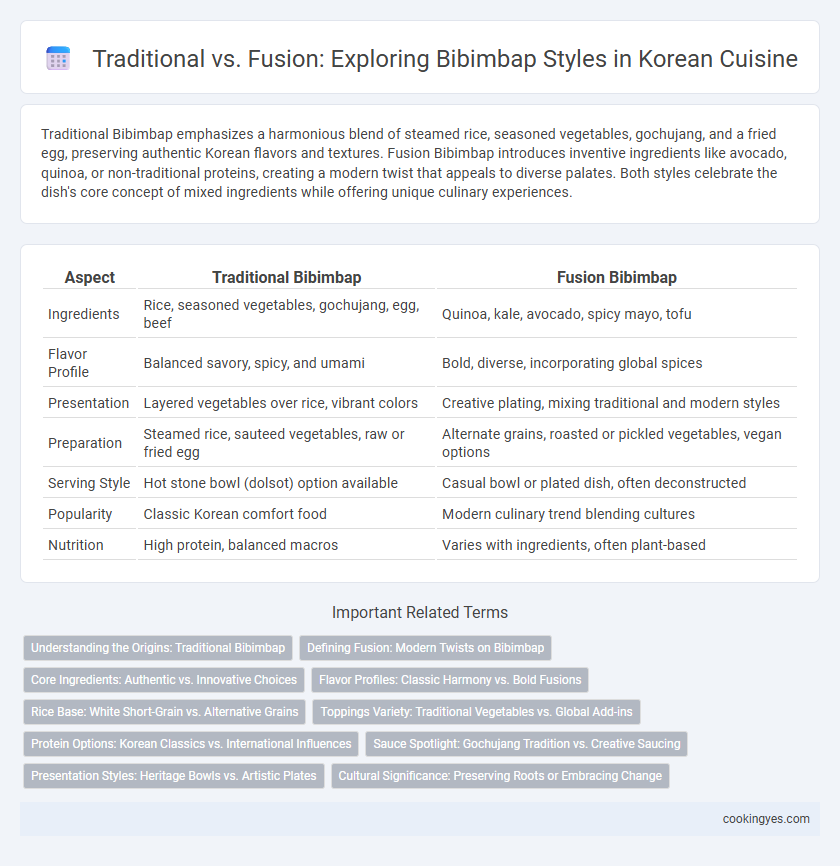Traditional Bibimbap emphasizes a harmonious blend of steamed rice, seasoned vegetables, gochujang, and a fried egg, preserving authentic Korean flavors and textures. Fusion Bibimbap introduces inventive ingredients like avocado, quinoa, or non-traditional proteins, creating a modern twist that appeals to diverse palates. Both styles celebrate the dish's core concept of mixed ingredients while offering unique culinary experiences.
Table of Comparison
| Aspect | Traditional Bibimbap | Fusion Bibimbap |
|---|---|---|
| Ingredients | Rice, seasoned vegetables, gochujang, egg, beef | Quinoa, kale, avocado, spicy mayo, tofu |
| Flavor Profile | Balanced savory, spicy, and umami | Bold, diverse, incorporating global spices |
| Presentation | Layered vegetables over rice, vibrant colors | Creative plating, mixing traditional and modern styles |
| Preparation | Steamed rice, sauteed vegetables, raw or fried egg | Alternate grains, roasted or pickled vegetables, vegan options |
| Serving Style | Hot stone bowl (dolsot) option available | Casual bowl or plated dish, often deconstructed |
| Popularity | Classic Korean comfort food | Modern culinary trend blending cultures |
| Nutrition | High protein, balanced macros | Varies with ingredients, often plant-based |
Understanding the Origins: Traditional Bibimbap
Traditional bibimbap originates from Korea, featuring steamed rice topped with seasoned vegetables, gochujang (red chili paste), and a fried egg, often accompanied by sliced beef. This style emphasizes harmony in flavors and textures, adhering to time-honored preparation methods and regional variations. Understanding traditional bibimbap highlights its cultural significance and the importance of ingredient balance, which fusion versions often reinterpret with global influences.
Defining Fusion: Modern Twists on Bibimbap
Fusion bibimbap incorporates contemporary ingredients and global flavors, redefining the traditional Korean dish while maintaining its core elements like rice and vegetables. Modern twists include using non-traditional proteins such as seafood or tofu varieties, incorporating international sauces like pesto or sriracha, and experimenting with plating techniques for visual appeal. This innovative approach caters to evolving tastes while honoring bibimbap's heritage.
Core Ingredients: Authentic vs. Innovative Choices
Bibimbap traditionally features core ingredients like steamed rice, sauteed vegetables, gochujang, and a fried egg, emphasizing balance and harmony rooted in Korean heritage. Fusion bibimbap experiments with innovative choices such as quinoa, kale, avocado, and various international sauces, blending global flavors with classic elements. The contrast between authentic and fusion bibimbap highlights how core ingredients evolve while maintaining the dish's essence.
Flavor Profiles: Classic Harmony vs. Bold Fusions
Traditional Bibimbap emphasizes balanced flavors with seasoned vegetables, savory gochujang, and tender marinated beef creating a harmonious and comforting taste experience. Fusion Bibimbap experiments with unconventional ingredients like kimchi tacos, spicy mayo, or grilled chicken, delivering bold and innovative flavor combinations that challenge classic expectations. The contrast between classic harmony and bold fusions highlights Bibimbap's versatility as both a cultural staple and a contemporary culinary canvas.
Rice Base: White Short-Grain vs. Alternative Grains
Traditional bibimbap features white short-grain rice known for its sticky texture and mild flavor, providing a neutral base that balances the vibrant toppings. Fusion variations experiment with alternative grains such as brown rice, quinoa, or black rice, introducing nutty flavors and added nutritional benefits like higher fiber and antioxidants. Choosing between these bases impacts the dish's authenticity and health profile, catering to diverse dietary preferences and modern culinary trends.
Toppings Variety: Traditional Vegetables vs. Global Add-ins
Traditional Bibimbap features a carefully selected array of local vegetables such as spinach, bean sprouts, and fernbrake, emphasizing authentic Korean flavors and textures. Fusion Bibimbap expands the toppings variety by incorporating global ingredients like avocado, grilled chicken, and cheese, creating a colorful and diverse flavor profile. This contrast highlights the balance between preserving cultural heritage and embracing innovative culinary influences.
Protein Options: Korean Classics vs. International Influences
Traditional bibimbap features classic Korean proteins such as marinated beef bulgogi, seasoned ground beef, or fried egg, highlighting authentic flavors and textures. Fusion bibimbap introduces international influences with options like grilled chicken, tofu, or seafood, catering to diverse palates and dietary preferences. This blend of protein choices enhances the dish's versatility while preserving its cultural essence.
Sauce Spotlight: Gochujang Tradition vs. Creative Saucing
Traditional Bibimbap highlights the bold, spicy sweetness of classic gochujang, a fermented red chili paste that anchors the dish's authentic Korean flavors. Fusion variations experiment by blending gochujang with unconventional ingredients like honey, soy, or citrus to create innovative sauces that complement diverse toppings. This creative saucing transforms Bibimbap into a versatile culinary canvas, balancing tradition with modern taste preferences.
Presentation Styles: Heritage Bowls vs. Artistic Plates
Traditional bibimbap is served in heritage stone bowls called dolsot, which retain heat and enhance flavors while offering a rustic, authentic presentation. Fusion bibimbap embraces artistic plates that prioritize visual appeal, incorporating vibrant garnishes and creative arrangements to elevate the dining experience. The contrast highlights a shift from cultural preservation to modern culinary innovation in presentation styles.
Cultural Significance: Preserving Roots or Embracing Change
Traditional Bibimbap preserves Korean cultural heritage by emphasizing authentic ingredients like seasoned vegetables, gochujang, and raw or lightly cooked egg, reflecting centuries-old culinary practices. Fusion Bibimbap adapts to global tastes by incorporating diverse ingredients such as avocado, cheese, or non-traditional proteins, showcasing cultural exchange and innovation. The balance between preserving roots and embracing change highlights how Bibimbap remains both a symbol of Korean identity and a versatile dish in contemporary cuisine.
Traditional vs Fusion for Bibimbap style Infographic

 cookingyes.com
cookingyes.com